Bosnia and Herzegovina – November/December 1993
The Bosnian War was a complex military conflict in the region of Bosnia and Herzegovina, between April 6th 1992 and December 14th 1995. The war was caused by a political, social and ethnic crisis following the end of the Cold War and the fall of the socialist system in Yugoslavia. A frenzy of nationalism, ethnic cleansing and genocide followed, killing an estimated 100,000 people and displacing 1.8 million.
The following selection of photographs and interviews were taken during a 3 week assignment to the enclave of Tuzla in eastern Bosnia during December 1993 on behalf of aid agency Oxfam. At that time Tuzla had been blockaded by Serbian Armed forces for 10 months. A small amount of humanitarian aid arrived by UNHCR convoy, the only other way to enter Tuzla was by UN helicopters.
My brief was to photograph the distribution of winter clothing and footwear to refugees, provide publicity images that will be used to raise public awareness to the plight facing refugees during the approaching winter and produce persuasive imagery for Oxfam’s 1994 ‘The Cold Front Appeal’.
I first travelled to Split in Croatia where I had the opportunity to photograph and interview a refugee family of Catholic Croats from the village of Vrlika whose entire population of 500 residents had been ethnically cleansed by Serbian Armed Forces in 1991. (see BOS 06/07).
As a temporary member of the UNHCR I then made my way by helicopter to the industrial city of Tuzla in eastern Bosnia were I was based for the remainder of this assignment. Tuzla is the third largest city in Bosnia and had been under siege by Serbian Army Forces for 10 months. Only limited UNHCR humanitarian convoys known as the ‘Tuzla Nomads’ were permitted road access into Tuzla.
On arrival in Tuzla a distinctive smell of raw sewage and wood smoke permeated throughout the city. In order to intimidate and create fear in the population Tuzla was randomly shelled each day from Serbian Army artillery positions 9km away. The power station had been damaged, which meant only limited electricity was available each day, often only one hour per day. Wood fires were the main source of heating and cooking, car batteries were charged when electricity was available which provided limited 12 volt lighting during the evenings.
The ethnic cleansing of Bosnian Muslims from the surrounding districts had doubled the city population, straining its already limited resources, refugees were housed in schools, sports halls and public buildings. Their lives were one of constant uncertainty, with no future and some a horrific past.
I shared a room with Oxfam’s Bosnia representative in Tuzla, Andrew Chadwick. A 7pm to 7am curfew was strictly enforced, as Serbian raiding parties were known to enter the city at night. The front door was securely barricaded each night, long cold nights were occasionally spent drinking illegally distilled slivovitz.
Not only was it persistently cold working in Tuzla, this assignment was made especially difficult as there was huge resentment towards ‘outsiders’, any assistance to me was limited. Bosnian Muslims justifiably considered they had been forgotten and abandoned by the western nations. Fortunately, I was assigned Oxfam’s programme manager Jasmina Husmanovic as translator and facilitator, her local knowledge and assistance was greatly appreciated.
I recorded two of these events on my dictaphone:
…”a solder came into the Oxfam office today and said his daughter was very ill and his family hungry. He said that unless he received some help he would kill his family and then kill himself, but before he did so he would make sure he took a lot of UNHCR staff with him. I gave him a 100 dinar note and he left, we all felt quite useless and wondered why we were all here”…
…”an elderly lady came up to me and threw a ball of ice in my face and shouted ‘help us we are starving’ I could do nothing and kept on walking”…
Images from this assignment were used widely in full page national newspaper campaigns and magazine articles to inform the public and appeal to governments to intervene in the forthcoming humanitarian catastrophe.

[BOS 01] Poster using image BOS 26 promoting ‘Mirad : A Boy from Bosnia’ at The Playhouse Oxford, January 1994. Dramatic readings by Sinead Cusack and Jeremy Irons were made in aid of the charity Bosnian Relief.

[BOS 02] Tens of thousands of postcards captioned ‘Mr President: I can no longer stand up against genocide…what’s your excuse?’ were printed during April 1994 at Stanford University, California, USA using this image BOS 43 of a wounded Bosnian soldier by Students Against GEnocide (SAGE). They were sent to President Bill Clinton protesting at the Serbian genocide and ethnic cleansing. They were demanding the lifting of an arms embargo which was denying the The Republic of Bosnia and Herzegovina the right to self-defence.

[BOS 03] This advertisement used image BOS 16 and captioned ‘Now, Mr Major, what about Tuzla?’ Full page advertisements where placed in the Independent, Guardian, Daily Telegraph and other national newspapers on Monday, 14th February 1994. The purpose of this advertising campaign by Oxfam was to raise awareness to the plight of a quarter of a million displaced people in the besieged city of Tuzla. These civilians where totally dependant on humanitarian aid that currently comes only infrequently overland. It is demanding that UK prime minister John Major takes action to open Tuzla airport so that aid can quickly and directly reach a population that is increasingly at risk of starvation. The advert says that only 20% of the food needed to sustain this population arrived by road last month, clearly the threat of starvation and malnutrition is increasing. It also makes the point that Tuzla, like Sarajevo is a designated UN ‘Safe Area’. Displaced people have a right to be protected from a war that continues to kill, maim and starve, especially the poor and elderly.

[BOS 04] ”Safe’ But not protected” was a newspaper advertising campaign produced by Oxfam using image BOS 26. Full page advertisements were placed in the Daily Telegraph, Guardian, Independent and other national newspapers on the Wednesday 19th July 1995. The purpose of the advertisement was to inform the UK public that ‘Safe Areas’ designated by the UN Security Council in 1993 were no longer places where civilians can be protected from the brutal violence affecting the region. It appeals to the British and other world governments to ensure that civilians in ‘Safe Areas’ are protected in accordance with the Geneva Conventions Universal Declaration of Human Rights. Sadly this advert coincided with the Srebrenica genocide between 11th-22nd July 1995 where over 8,000 men and boys were executed. These killings were the single largest massacre of civilians since WW2.

[BOS 05] An illustrated report using cover image BOS 16 and others produced by Oxfam detailing their work in Eastern Europe and the former Soviet Union. September 1994.

[BOS 01] Poster using image BOS 26 promoting ‘Mirad : A Boy from Bosnia’ at The Playhouse Oxford, January 1994. Dramatic readings by Sinead Cusack and Jeremy Irons were made in aid of the charity Bosnian Relief.

[BOS 02] Tens of thousands of postcards captioned ‘Mr President: I can no longer stand up against genocide…what’s your excuse?’ were printed during April 1994 at Stanford University, California, USA using this image BOS 43 of a wounded Bosnian soldier by Students Against GEnocide (SAGE). They were sent to President Bill Clinton protesting at the Serbian genocide and ethnic cleansing. They were demanding the lifting of an arms embargo which was denying the The Republic of Bosnia and Herzegovina the right to self-defence.

[BOS 03] This advertisement used image BOS 16 and captioned ‘Now, Mr Major, what about Tuzla?’ Full page advertisements where placed in the Independent, Guardian, Daily Telegraph and other national newspapers on Monday, 14th February 1994. The purpose of this advertising campaign by Oxfam was to raise awareness to the plight of a quarter of a million displaced people in the besieged city of Tuzla. These civilians where totally dependant on humanitarian aid that currently comes only infrequently overland. It is demanding that UK prime minister John Major takes action to open Tuzla airport so that aid can quickly and directly reach a population that is increasingly at risk of starvation. The advert says that only 20% of the food needed to sustain this population arrived by road last month, clearly the threat of starvation and malnutrition is increasing. It also makes the point that Tuzla, like Sarajevo is a designated UN ‘Safe Area’. Displaced people have a right to be protected from a war that continues to kill, maim and starve, especially the poor and elderly.

[BOS 04] ”Safe’ But not protected” was a newspaper advertising campaign produced by Oxfam using image BOS 26. Full page advertisements were placed in the Daily Telegraph, Guardian, Independent and other national newspapers on the Wednesday 19th July 1995. The purpose of the advertisement was to inform the UK public that ‘Safe Areas’ designated by the UN Security Council in 1993 were no longer places where civilians can be protected from the brutal violence affecting the region. It appeals to the British and other world governments to ensure that civilians in ‘Safe Areas’ are protected in accordance with the Geneva Conventions Universal Declaration of Human Rights. Sadly this advert coincided with the Srebrenica genocide between 11th-22nd July 1995 where over 8,000 men and boys were executed. These killings were the single largest massacre of civilians since WW2.

[BOS 05] An illustrated report using cover image BOS 16 and others produced by Oxfam detailing their work in Eastern Europe and the former Soviet Union. September 1994.
The following black and white photographs were originally shot on 35mm b/w film and have been digitised.
These first two photographs and interviews were made at the Hotel Marjan, Split, Croatia.
The Hotel Marjan had been a former tourist hotel that had been requisitioned to house 500 refugees from the village of Vjliva. The interviewee and her family were part of the non Serbian population that were expelled or ‘ethnically cleansed’, from their village by Serbian Armed Forces in 1991.

[BOS 06] Croatian refugee at the Hotel Marjan, Split.
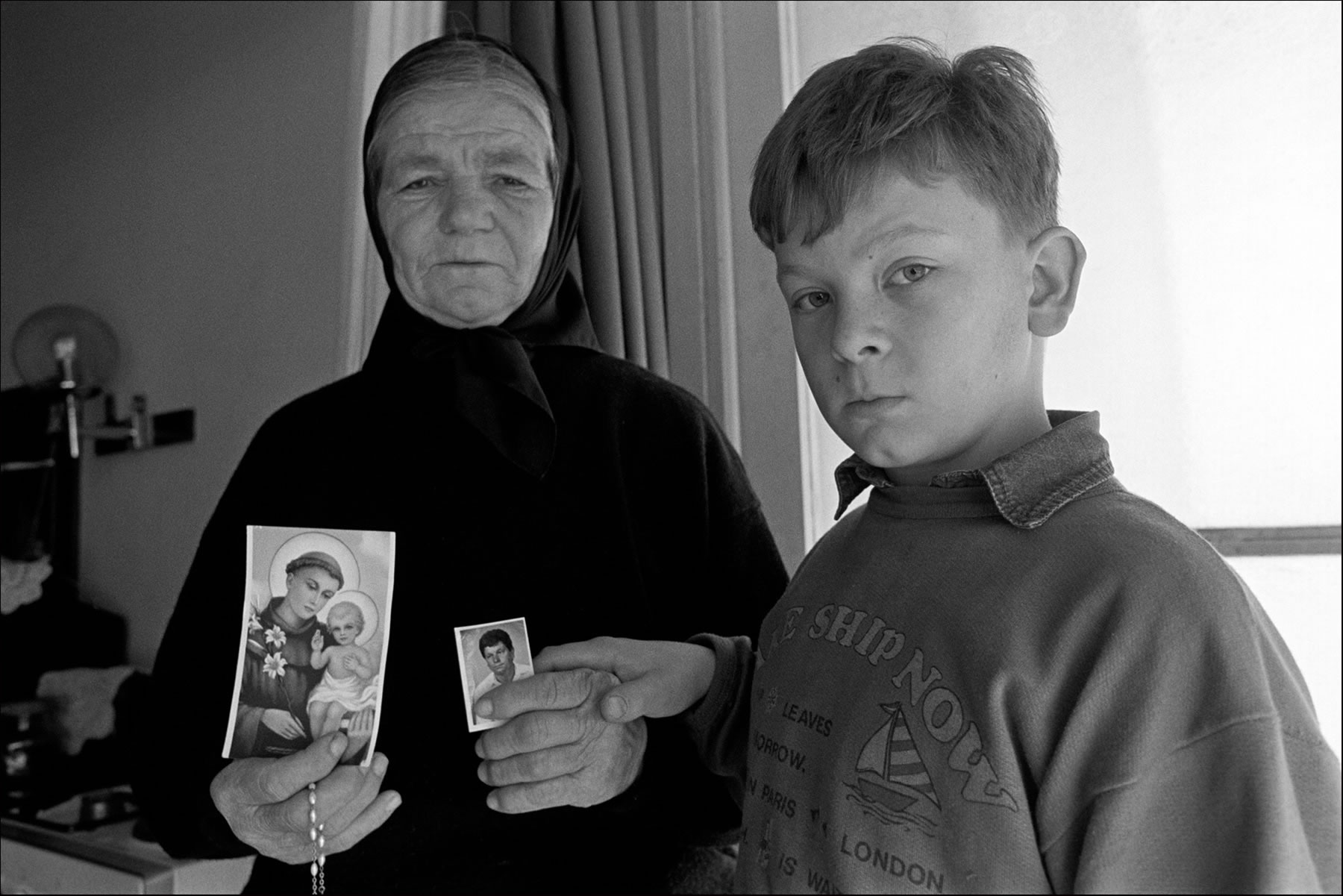
[BOS 07] Croatian refugee and her grandson at the Hotel Marjan, Split.
This interview was carried out with the daughter of the woman featured in the photographs above, she did not want to be photographed or named.
“We are Catholic Croats from the village of Vrlika, around 40 km from here. On the 25th of August 1991, Serbs, some of whom were our neighbours came to the house and beat us and took our money. My mother (photo BOS 01 and BOS 02) had her teeth knocked out during the beating. Vrlika was later burnt to the ground by Serb ‘Chetniks’ at the end of 1991, it was the second time for us, as our houses and churches were burnt by them during WWII.
Between that war and this one things seemed good between us Croats and the Serbians, but you cannot tell what Serbs really think in their minds. We had intermarried with some of our Serbian neighbours; we are not political, we are Roman Catholics, some of the Serbians are communist.
When we first arrived here we were optimistic about returning to our village, however now we are depressed living here and are now pessimistic about the future. Many people have died at this hotel. They have died from broken hearts and losing hope. A man killed himself in the lobby last week because his government cheque did not arrive. We cannot see what kind of a future there is for us. Some of us believe they can still see our ruined houses at Vrlika from the top of this hotel“.
The following photographs were taken en route and at the besieged and encircled industrial city of Tuzla in northern Bosnia were I was based for 2 weeks. The only route at that time into the city for personnel was by UN helicopter.

[BOS 08] French UN pilot takes a break while his Puma helicopter refuels en-route from Split to Tuzla air base. My journey to Tuzla was made by ‘bidding’ for a place on UN helicopters. The bidding process meant that anyone with a higher priority than myself was given a seat. My low level of priority meant it took four days to get to Tuzla. The journey was made by Gazelle and Puma helicopters. I was issued with a bullet proof jacket by Oxfam which on the advice of the other helicopter occupants should be removed and sat on as any gunfire was expected to come through the floor.

[BOS 09] Terry Hopper is a UNHCR convoy driver from Cambridgeshire, UK and has been a driver for 6 months. He said that at first he started driving for the money but now it is for humanitarian reasons. He said, “The drivers ease the stress each day by talking about it with each other, we are called ‘The Tuzla Nomads'”.

[BOS 10] Rudarska is the main highway running through Tuzla. The building on the right is pockmarked from an artillery shell. The blockade has meant that no petrol or diesel fuel has been delivered for transport, everyone therefore has to walk.
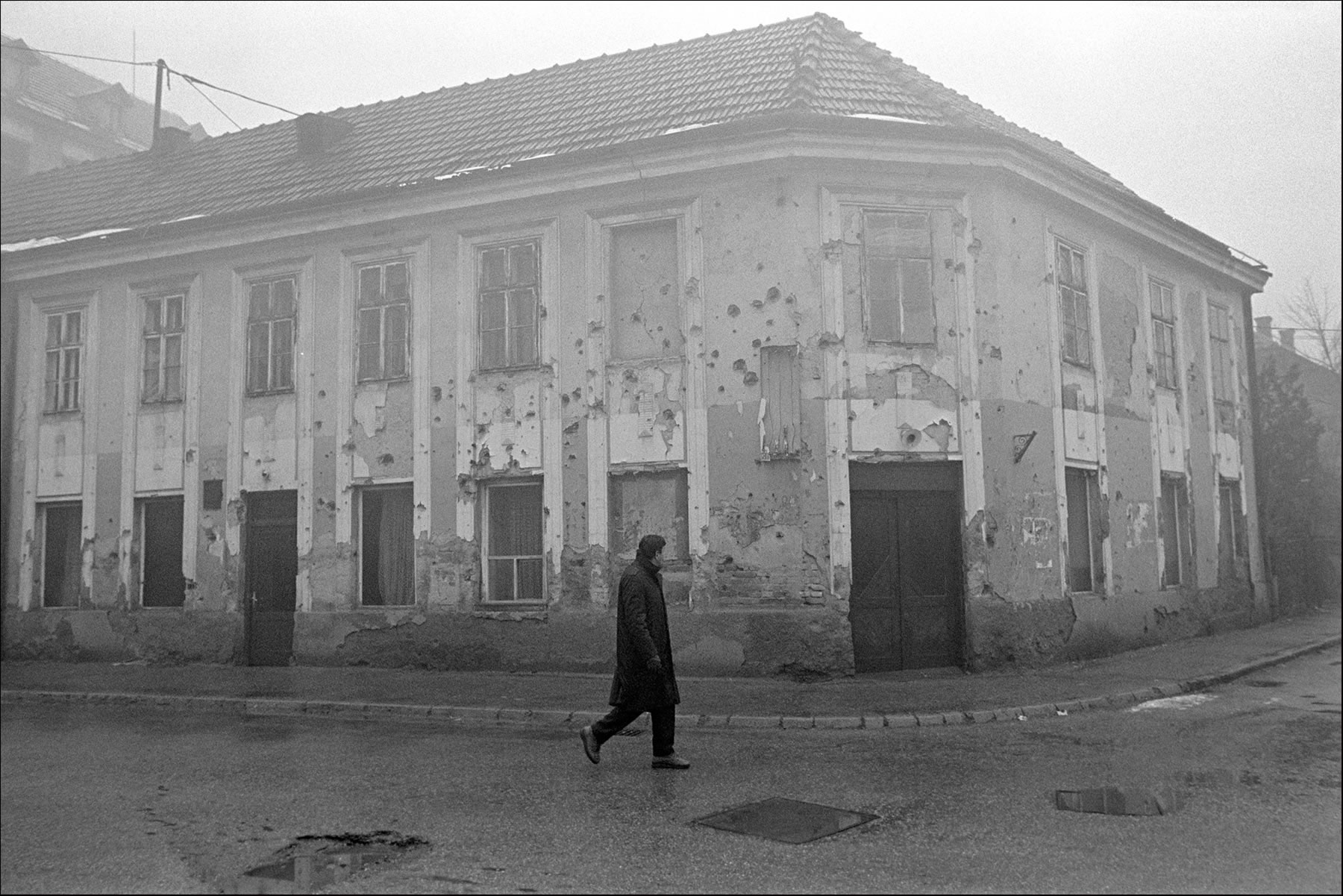
[BOS 11] Building pockmarked from an artillery shell. Tuzla was randomly shelled each day from Serbian artillery positions seven miles away.

[BOS 12] Collecting firewood from the outskirts of Tuzla.

[BOS 13] Fog and wood smoke, a winter street scene in Tuzla. During the blockade often only one hour of electricity was available each day, the tree tops (left) have been cut off and used for firewood.

[BOS 14] Horse drawn carts are used for transport. The blockade has meant no petrol or diesel has been delivered for several months.

[BOS 15] Men unfit for military service gather in the market at Gradska Pijaca where used wood and coal burning cooking stoves are being sold.

[BOS 16] Refugee mother and child. This photograph was used to promote Oxfam’s ‘Cold Front Appeal’, 1994. It was used prominently in full page nation newspaper advertisements to raise awareness of the plight Bosnian Muslims are facing during the coming winter months. See BOS 03.
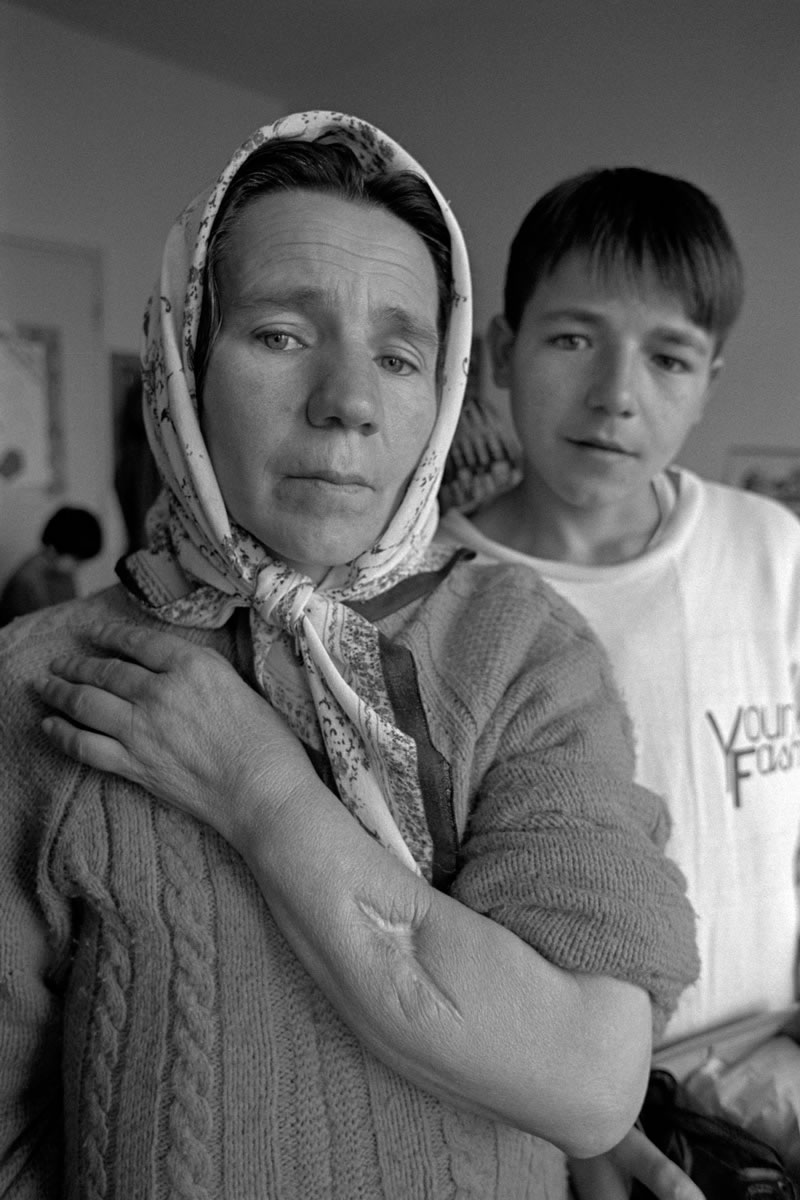
[BOS 17] This woman (age 43) and her son (age 14) are from a village near Srebrenica. She made this statement:
“I was wounded during a Serbian attack on my village and with the help of my brother was dragged to safety and evacuated to Tuzla by helicopter. I was able to survive and escape from the initial Serbian attack due to a strong counter-attack made by the Bosnian Muslim Army which briefly retook the village. The village was later retaken and is now back under Serbian control, however my husband and my other children are still trapped in the village. We do not have shoes for the winter and do not have enough to eat. Our life is hard as a refugee, we have no money, job or relatives nearby and are completely dependant on humanitarian aid“.

[BOS 18] Elderly man reading the Koran at a school being used to house refugees displaced from outlying villages.

[BOS 19] Elderly man and his grandson at the refugee centre.

[BOS 20] Refugee women knitting winter clothing at the refugee centre, the wool was supplied by Oxfam.

[BOS 21] Winter clothing and shoes from Oxfam being unloaded into a secure distribution centre #1.

[BOS 22] Winter clothing and shoes from Oxfam being unloaded into a secure distribution centre #2.

[BOS 23] EC humanitarian aid being unloaded from a recently arrived UNHCR convoy.

[BOS 24] Warehousemen at a UNHCR aid storage depot.

[BOS 25] Refugee boy begs through the fence of a UNHCR aid storage depot asking for food and money.

[BOS 26] This photograph of a refugee boy was used on the Oxford Playhouse production poster for ‘Mirad:A Boy from Bosnia’ and the “‘Safe But not protected” newspaper campaign.

[BOS 27] Refugees queue in the rain to enter Oxfam’s clothing distribution shop.
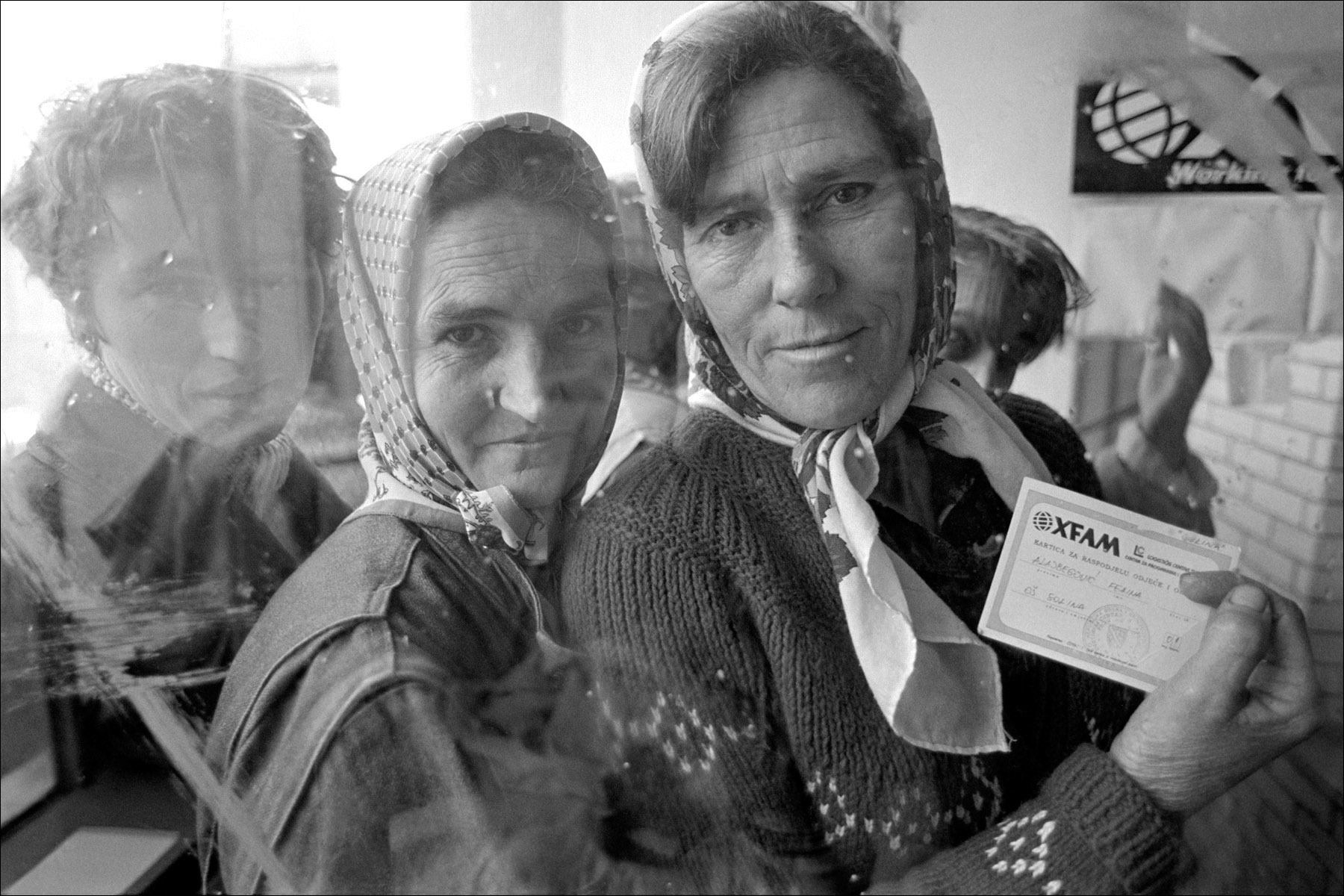
[BOS 28] Refugee with Oxfam clothing entitlement card.

[BOS 29] Woman and her son with his new trainers.

[BOS 30] Mother and children with their new winter shoes provided by Oxfam.

[BOS 31] Man selling cigarettes and soap from a box in the Mosnik district.

[BOS 32] Woman selling cigarettes, matches and secondhand clothing from a makeshift stall.

[BOS 33] Boys try to make a little money for their families selling smuggled cigarettes.

[BOS 34] Street boys. With absent parents, boys wander the streets.

[BOS 35] Girl at refugee centre.

[BOS 36] Elderly man with neck goitre returns home through the Mosnik district from the market with the only food he can afford, a cabbage.

[BOS 37] Elderly woman living in housing block with limited electricity, soup and bread is delivered to her from a community canteen.

[BOS 38] Exhausted doctor and orderlies at a field dressing station on the outskirts of Tuzla.

[BOS 39] Recently wounded soldier is visited by his friends at a field dressing station. Tuzla was protected by a trench system that encircled the city.

[BOS 40] Wounded soldier at a field dressing station.

[BOS 41] Wounded soldier with his doctor and parents in the basement of a field dressing station.
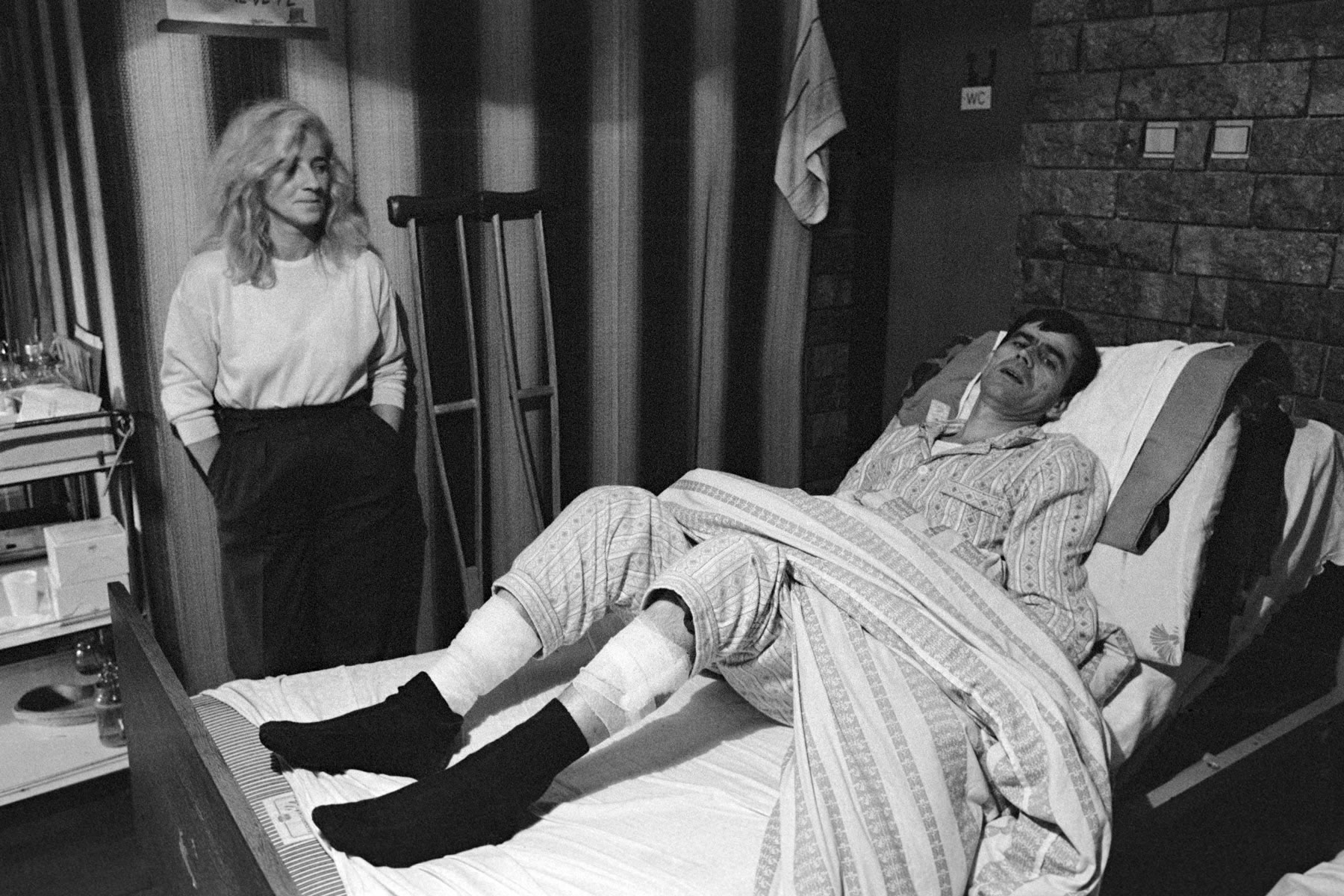
[BOS 42] Wounded soldier and doctor in the basement of a field dressing station.

[BOS 43] Emil Razvaliac aged 25 is a double amputee and former waiter.
He made this statement: “I am a soldier injured by a mortar shell in Srebrenica which killed my two friends, I was transported to hospital two days later. I consider myself lucky as the shell landed at my feet, cutting my legs off immediately, however, the trajectory of the shrapnel hit my comrades in the chest and head killing them. I want to return to the front line again and want to thank Handicap International for my new legs and jeans“.
This photograph of Emil was used by Students Against GEnocide (SAGE), see BOS 02 as a postcard and sent in their thousands to President Bill Clinton appealing to him to lift an arms embargo.

[BOS 44] Civilian amputees injured by bomblets from cluster bombs. Cluster bombs were dropped over a wide area surrounding Tuzla from Serbian jets. These bomblets are designed to detonate and maim when stood on or touched.

[BOS 45] Double amputee soldier, the plaster on the window covers a bullet hole.

[BOS 46] Civilian and military amputees at a rehabilitation centre.

[BOS 47] Double amputee soldier practices walking down the corridor.

[BOS 48] Staff at Oxfam’s office Tuzla, December 1993. Many thanks to Oxfam’s Bosnia representative in Tuzla, Andrew Chadwick and Jasmina Husmanovic Oxfam’s programme manager, translator and facilitator, front row, far right.
The following selection of digitised photographs where originally shot on 35mm colour transparency film.

[BOS 49] People rush past a building recently pockmarked from an artillery shell in the central district of Korzo. Tuzla was randomly shelled from Serbian artillery positions seven miles away.

[BOS 50] Men unfit for military service drink in the Gradska Pijaca market place.

[BOS 51] Solders march down the main road through Irac. Photographed from Oxfam’s Land Rover.

[BOS 52] Boy sits in the ruins of a house destroyed by a Serbian artillery shell. His badge says ARMIJ which is the Army of the Republic of Bosnia and Herzegovina.

[BOS 53] Doctors outside a field dressing station on the outskirts of Tuzla.

[BOS 54] Wounded soldier at a field dressing station.

[BOS 55] View of the empty M4, the main road through Tuzla.

[BOS 56] Drunk man wanders around the streets asking people for cigarettes.

[BOS 57] Wood and coal smoke from domestic fires partly obscures the city at sunset. Photograph taken from the bridge at Irac over looking the river Jala.

[BOS 58] Man returns from woodland on the outskirts of Tuzla with fire wood.

[BOS 59] Defiant boys outside the orphanage near Focanska.

[BOS 60] Boys take a break from working in the orphanage garden.
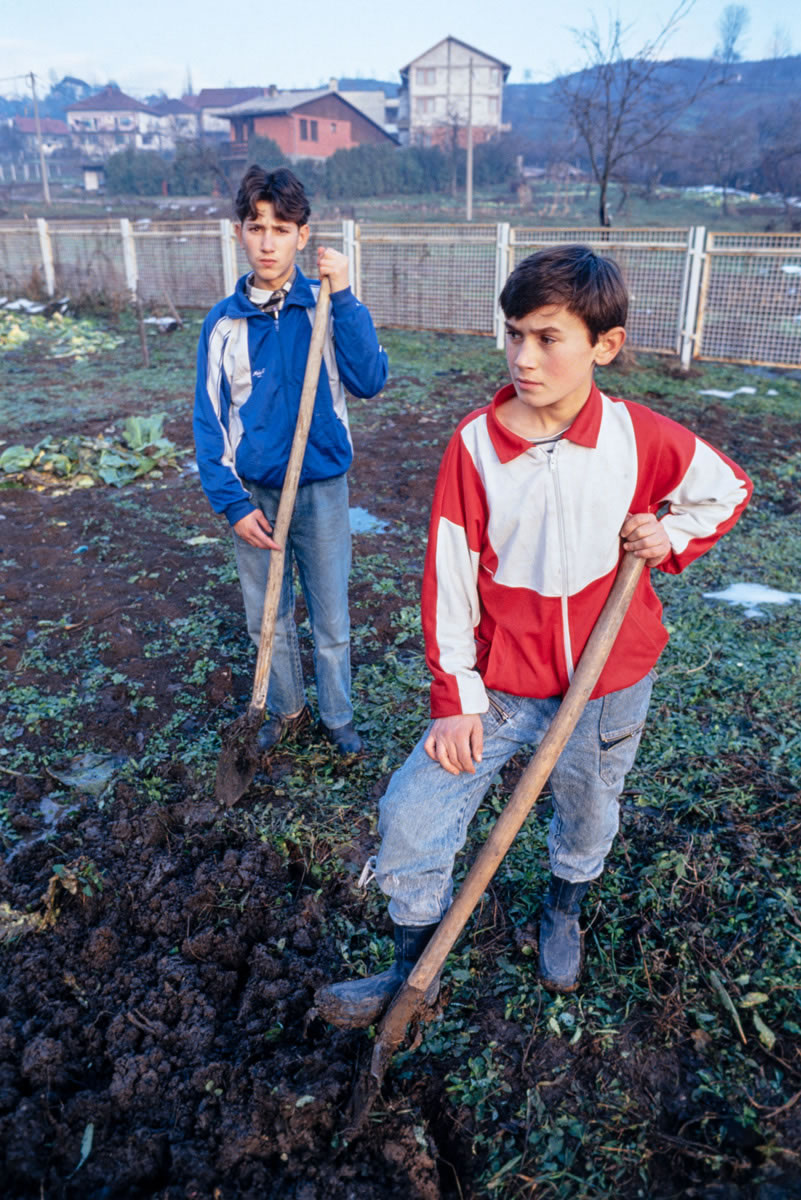
[BOS 61] Boys preparing the soil to grow cabbages in the orphanage garden

[BOS 62] Girls carry clean water to the orphanage kitchen.

[BOS 63] Boy shows me his badly decayed teeth.

[BOS 64] Girl at a refugee centre.

[BOS 65] Boy carrying soup and bread from a community canteen to his refugee living in a tower block.

[BOS 66] Man selling mouse poison and mouse glue in the Gradska Pijaca market place.

[BOS 67] Woman selling tobacco in the Gradska Pijaca market place.

[BOS 68] Woman looks out from her barricaded house.

[BOS 69] Many thanks to Jasmina Husmanovic Oxfam’s programme manager, translator and facilitator in Tuzla.
My return journey to Split from Tuzla was made overland by a UN armoured personnel carrier to the Holiday Inn, Sarajevo, then by C-130 Hercules military transporter to Split airport.
Sarajevo was encircled by the Bosnian Serb Army forces between April 1992 -Feb 1996, known as the ‘Siege of Sarajevo’. It was the longest siege of a city in the history of modern warfare. High ground around the city gave snipers an extensive field of fire. The main road out of the city to the airport was infamously known as ‘Sniper Alley’ due to large number of sniper positions that aimed to control all movement in the city.

[BOS 70] Early morning view of the twin Unis Towers nicknamed Momo and Uzeir opposite the Holiday Inn. They were extensively damaged by shelling in June 1992 and became symbols of resistance during the ‘Siege of Sarajevo’.

[BOS 71] View from a lightly armoured UN Land Rover travelling along ‘Sniper Alley’ en route to Sarajevo airport.
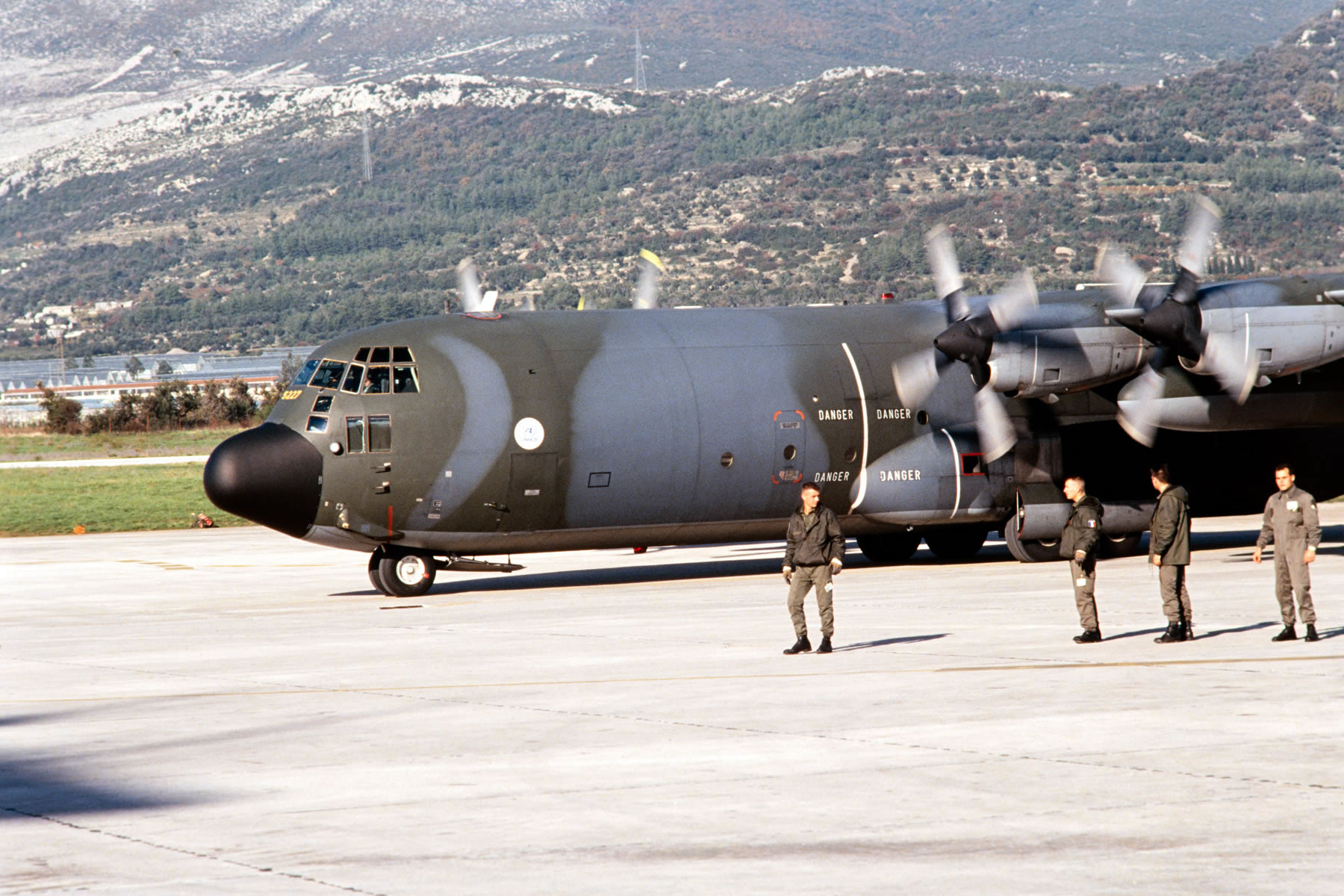
[BOS 72] Arrival at Split Airport, Croatia by UNHCR C-130 Hercules military transport aircraft.
All images are Strictly Copyright © Bill Stephenson All Rights Reserved
The following black and white photographs were originally shot on 35mm b/w film and have been digitised.
These first two photographs and interviews were made at the Hotel Marjan, Split, Croatia.
The Hotel Marjan had been a former tourist hotel that had been requisitioned to house 500 refugees from the village of Vjliva. The interviewee and her family were part of the non Serbian population that were expelled or ‘ethnically cleansed’, from their village by Serbian Armed Forces in 1991.

[BOS 06] Croatian refugee at the Hotel Marjan, Split.

[BOS 07] Croatian refugee and her grandson at the Hotel Marjan, Split.
This interview was carried out with the daughter of the woman featured in the photographs above, she did not want to be photographed or named.
“We are Catholic Croats from the village of Vrlika, around 40 km from here. On the 25th of August 1991, Serbs, some of whom were our neighbours came to the house and beat us and took our money. My mother (photo BOS 01 and BOS 02) had her teeth knocked out during the beating. Vrlika was later burnt to the ground by Serb ‘Chetniks’ at the end of 1991, it was the second time for us, as our houses and churches were burnt by them during WWII.
Between that war and this one things seemed good between us Croats and the Serbians, but you cannot tell what Serbs really think in their minds. We had intermarried with some of our Serbian neighbours; we are not political, we are Roman Catholics, some of the Serbians are communist.
When we first arrived here we were optimistic about returning to our village, however now we are depressed living here and are now pessimistic about the future. Many people have died at this hotel. They have died from broken hearts and losing hope. A man killed himself in the lobby last week because his government cheque did not arrive. We cannot see what kind of a future there is for us. Some of us believe they can still see our ruined houses at Vrlika from the top of this hotel“.
The following photographs were taken en route and at the besieged and encircled industrial city of Tuzla in northern Bosnia were I was based for 2 weeks. The only route at that time into the city for personnel was by UN helicopter.

[BOS 08] French UN pilot takes a break while his Puma helicopter refuels en-route from Split to Tuzla air base. My journey to Tuzla was made by ‘bidding’ for a place on UN helicopters. The bidding process meant that anyone with a higher priority than myself was given a seat. My low level of priority meant it took four days to get to Tuzla. The journey was made by Gazelle and Puma helicopters. I was issued with a bullet proof jacket by Oxfam which on the advice of the other helicopter occupants should be removed and sat on as any gunfire was expected to come through the floor.

[BOS 09] Terry Hopper is a UNHCR convoy driver from Cambridgeshire, UK and has been a driver for 6 months. He said that at first he started driving for the money but now it is for humanitarian reasons. He said, “The drivers ease the stress each day by talking about it with each other, we are called ‘The Tuzla Nomads'”.

[BOS 10] Rudarska is the main highway running through Tuzla. The building on the right is pockmarked from an artillery shell. The blockade has meant that no petrol or diesel fuel has been delivered for transport, everyone therefore has to walk.

[BOS 11] Building pockmarked from an artillery shell. Tuzla was randomly shelled each day from Serbian artillery positions seven miles away.

[BOS 12] Collecting firewood from the outskirts of Tuzla.

[BOS 13] Fog and wood smoke, a winter street scene in Tuzla. During the blockade often only one hour of electricity was available each day, the tree tops (left) have been cut off and used for firewood.

[BOS 14] Horse drawn carts are used for transport. The blockade has meant no petrol or diesel has been delivered for several months.

[BOS 15] Men unfit for military service gather in the market at Gradska Pijaca where used wood and coal burning cooking stoves are being sold.

[BOS 16] Refugee mother and child. This photograph was used to promote Oxfam’s ‘Cold Front Appeal’, 1994. It was used prominently in full page nation newspaper advertisements to raise awareness of the plight Bosnian Muslims are facing during the coming winter months. See BOS 03.

[BOS 17] This woman (age 43) and her son (age 14) are from a village near Srebrenica. She made this statement:
“I was wounded during a Serbian attack on my village and with the help of my brother was dragged to safety and evacuated to Tuzla by helicopter. I was able to survive and escape from the initial Serbian attack due to a strong counter-attack made by the Bosnian Muslim Army which briefly retook the village. The village was later retaken and is now back under Serbian control, however my husband and my other children are still trapped in the village. We do not have shoes for the winter and do not have enough to eat. Our life is hard as a refugee, we have no money, job or relatives nearby and are completely dependant on humanitarian aid“.

[BOS 18] Elderly man reading the Koran at a school being used to house refugees displaced from outlying villages.

[BOS 19] Elderly man and his grandson at the refugee centre.

[BOS 20] Refugee women knitting winter clothing at the refugee centre, the wool was supplied by Oxfam.

[BOS 21] Winter clothing and shoes from Oxfam being unloaded into a secure distribution centre #1.

[BOS 22] Winter clothing and shoes from Oxfam being unloaded into a secure distribution centre #2.

[BOS 23] EC humanitarian aid being unloaded from a recently arrived UNHCR convoy.

[BOS 24] Warehousemen at a UNHCR aid storage depot.

[BOS 25] Refugee boy begs through the fence of a UNHCR aid storage depot asking for food and money.

[BOS 26] This photograph of a refugee boy was used on the Oxford Playhouse production poster for ‘Mirad:A Boy from Bosnia’ and the “‘Safe But not protected” newspaper campaign.

[BOS 27] Refugees queue in the rain to enter Oxfam’s clothing distribution shop.

[BOS 28] Refugee with Oxfam clothing entitlement card.

[BOS 29] Woman and her son with his new trainers.

[BOS 30] Mother and children with their new winter shoes provided by Oxfam.

[BOS 31] Man selling cigarettes and soap from a box in the Mosnik district.

[BOS 32] Woman selling cigarettes, matches and secondhand clothing from a makeshift stall.

[BOS 33] Boys try to make a little money for their families selling smuggled cigarettes.

[BOS 34] Street boys. With absent parents, boys wander the streets.

[BOS 35] Girl at refugee centre.

[BOS 36] Elderly man with neck goitre returns home through the Mosnik district from the market with the only food he can afford, a cabbage.

[BOS 37] Elderly woman living in housing block with limited electricity, soup and bread is delivered to her from a community canteen.

[BOS 38] Exhausted doctor and orderlies at a field dressing station on the outskirts of Tuzla.

[BOS 39] Recently wounded soldier is visited by his friends at a field dressing station. Tuzla was protected by a trench system that encircled the city.

[BOS 40] Wounded soldier at a field dressing station.

[BOS 41] Wounded soldier with his doctor and parents in the basement of a field dressing station.

[BOS 42] Wounded soldier and doctor in the basement of a field dressing station.

[BOS 43] Emil Razvaliac aged 25 is a double amputee and former waiter.
He made this statement: “I am a soldier injured by a mortar shell in Srebrenica which killed my two friends, I was transported to hospital two days later. I consider myself lucky as the shell landed at my feet, cutting my legs off immediately, however, the trajectory of the shrapnel hit my comrades in the chest and head killing them. I want to return to the front line again and want to thank Handicap International for my new legs and jeans“.
This photograph of Emil was used by Students Against GEnocide (SAGE), see BOS 02 as a postcard and sent in their thousands to President Bill Clinton appealing to him to lift an arms embargo.

[BOS 44] Civilian amputees injured by bomblets from cluster bombs. Cluster bombs were dropped over a wide area surrounding Tuzla from Serbian jets. These bomblets are designed to detonate and maim when stood on or touched.

[BOS 45] Double amputee soldier, the plaster on the window covers a bullet hole.

[BOS 46] Civilian and military amputees at a rehabilitation centre.

[BOS 47] Double amputee soldier practices walking down the corridor.

[BOS 48] Staff at Oxfam’s office Tuzla, December 1993. Many thanks to Oxfam’s Bosnia representative in Tuzla, Andrew Chadwick and Jasmina Husmanovic Oxfam’s programme manager, translator and facilitator, front row, far right.
The following selection of digitised photographs where originally shot on 35mm colour transparency film.

[BOS 49] People rush past a building recently pockmarked from an artillery shell in the central district of Korzo. Tuzla was randomly shelled from Serbian artillery positions seven miles away.

[BOS 50] Men unfit for military service drink in the Gradska Pijaca market place.

[BOS 51] Solders march down the main road through Irac. Photographed from Oxfam’s Land Rover.

[BOS 52] Boy sits in the ruins of a house destroyed by a Serbian artillery shell. His badge says ARMIJ which is the Army of the Republic of Bosnia and Herzegovina.

[BOS 53] Doctors outside a field dressing station on the outskirts of Tuzla.

[BOS 54] Wounded soldier at a field dressing station.

[BOS 55] View of the empty M4, the main road through Tuzla.

[BOS 56] Drunk man wanders around the streets asking people for cigarettes.

[BOS 57] Wood and coal smoke from domestic fires partly obscures the city at sunset. Photograph taken from the bridge at Irac over looking the river Jala.

[BOS 58] Man returns from woodland on the outskirts of Tuzla with fire wood.

[BOS 59] Defiant boys outside the orphanage near Focanska.

[BOS 60] Boys take a break from working in the orphanage garden.

[BOS 61] Boys preparing the soil to grow cabbages in the orphanage garden

[BOS 62] Girls carry clean water to the orphanage kitchen.

[BOS 63] Boy shows me his badly decayed teeth.

[BOS 64] Girl at a refugee centre.

[BOS 65] Boy carrying soup and bread from a community canteen to his family living in a tower block.

[BOS 66] Man selling mouse poison and mouse glue in the Gradska Pijaca market place.

[BOS 67] Woman selling tobacco in the Gradska Pijaca market place.

[BOS 68] Woman looks out from her barricaded house.

[BOS 69] Many thanks to Jasmina Husmanovic Oxfam’s programme manager, translator and facilitator in Tuzla.
My return journey to Split from Tuzla was made overland by a UN armoured personnel carrier to the Holiday Inn, Sarajevo, then by C-130 Hercules military transporter to Split airport.
Sarajevo was encircled by the Bosnian Serb Army forces between April 1992 -Feb 1996, known as the ‘Siege of Sarajevo’. It was the longest siege of a city in the history of modern warfare. High ground around the city gave snipers an extensive field of fire. The main road out of the city to the airport was infamously known as ‘Sniper Alley’ due to large number of sniper positions that aimed to control all movement in the city.

[BOS 70] Early morning view of the twin Unis Towers nicknamed Momo and Uzeir opposite the Holiday Inn. They were extensively damaged by shelling in June 1992 and became symbols of resistance during the ‘Siege of Sarajevo’.

[BOS 71] View from a lightly armoured UN Land Rover travelling along ‘Sniper Alley’ en route to Sarajevo airport.

[BOS 72] Arrival at Split Airport, Croatia by UNHCR C-130 Hercules military transport aircraft.
All images are Strictly Copyright © Bill Stephenson All Rights Reserved
